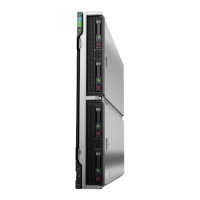For more information, see the HPE Persistent Memory User Guide on the Hewlett Packard Enterprise
website (http://www.hpe.com/info/persistentmemory-docs).
Requirements for relocating HPE Persistent Memory modules or a set of HPE Persistent Memory
modules when the data does not have to be preserved
• Move the HPE Persistent Memory modules to the new location and sanitize all HPE Persistent Memory
modules after installing them to the new location.
• Observe the DIMM and HPE Persistent Memory module population guidelines.
• Observe the process for removing an HPE Persistent Memory module.
• Observe the process for installing an HPE Persistent Memory module.
• Review and configure the system settings for HPE Persistent Memory.
For more information, see the HPE Persistent Memory User Guide on the Hewlett Packard Enterprise website
(http://www.hpe.com/info/persistentmemory-docs).
HPE Persistent Memory module sanitization
Media sanitization is defined by NIST SP800-88 Guidelines for Media Sanitization (Rev 1, Dec 2014) as "a
general term referring to the actions taken to render data written on media unrecoverable by both ordinary
and extraordinary means."
The specification defines the following levels:
• Clear: Overwrite user-addressable storage space using standard write commands; might not sanitize data
in areas not currently user-addressable (such as bad blocks and over-provisioned areas).
• Purge: Overwrite or erase all storage space that might have been used to store data using dedicated
device sanitize commands, such that data retrieval is "infeasible using state-of-the-art laboratory
techniques."
• Destroy: Ensure that data retrieval is "infeasible using state-of-the-art laboratory techniques" and render
the media unable to store data (such as disintegrate, pulverize, melt, incinerate, or shred).
HPE Persistent Memory supports the purge level using a cryptographic erase technique and an overwrite
technique.
HPE ProLiant and HPE Synergy Gen10 server products support sanitizing HPE Persistent Memory modules
during POST. Use the HPE RESTful Interface Tool or UEFI System Utilities to schedule sanitization on the
next boot.
For more information, see the following sections in the HPE Persistent Memory User Guide on the Hewlett
Packard Enterprise website (http://www.hpe.com/info/persistentmemory-docs):
• Sanitization policies
• Sanitization guidelines
NIST SP800-88 Guidelines for Media Sanitization (Rev 1, Dec 2014) is available for download from the NIST
website (http://nvlpubs.nist.gov/nistpubs/SpecialPublications/NIST.SP.800-88r1.pdf).
HPE Smart Storage Battery
The HPE Smart Storage Battery supports the following devices:
50 Removal and replacement procedures

